The Train Protection & Warning System (TPWS) is a train protection system used throughout the British passenger main-line railway network, and in Victoria, Australia.

In railway signalling, an interlocking is an arrangement of signal apparatus that prevents conflicting movements through an arrangement of tracks such as junctions or crossings. In North America, a set of signalling appliances and tracks interlocked together are sometimes collectively referred to as an interlocking plant or just as an interlocking. An interlocking system is designed so that it is impossible to display a signal to proceed unless the route to be used is proven safe.

A balise is an electronic beacon or transponder placed between the rails of a railway as part of an automatic train protection (ATP) system. The French word balise is used to distinguish these beacons from other kinds of beacons.
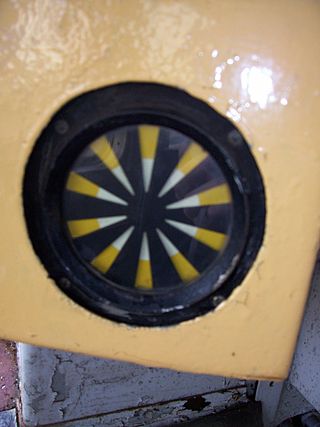
Automatic Warning System (AWS) is a railway safety system invented and predominantly used in the United Kingdom. It provides a train driver with an audible indication of whether the next signal they are approaching is clear or at caution. Depending on the upcoming signal state, the AWS will either produce a 'horn' sound, or a 'bell' sound. If the train driver fails to acknowledge a warning indication, an emergency brake application is initiated by the AWS. However if the driver correctly acknowledges the warning indication by pressing an acknowledgement button, then a visual 'sunflower' is displayed to the driver, as a reminder of the warning.

Part of a railway signalling system, a train stop, trip stop or tripcock is a train protection device that automatically stops a train if it attempts to pass a signal when the signal aspect and operating rules prohibit such movement, or if it attempts to pass at an excessive speed.
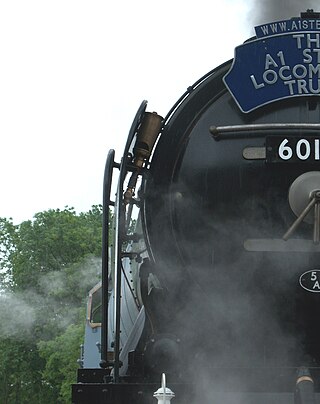
A train whistle or air whistle is an audible signaling device on a steam or gas locomotive, used to warn that the train is approaching, and to communicate with rail workers. Modern diesel and electric locomotives primarily use a powerful air horn instead of a whistle as an audible warning device. However, the word whistle continues to be used by railroaders in referring to such signaling practices as "whistling off".
In telephony, call progress tones are audible tones that provide an indication of the status of a telephone call to the user. The tones are generated by a central office or a private branch exchange (PBX) to the calling party.

PZB or Indusi is an intermittent cab signalling system and train protection system used in Germany, Austria, Slovenia, Croatia, Romania, Israel, Serbia, on two lines in Hungary, on the Tyne and Wear Metro in the UK, and formerly on the Trillium Line in Canada.

Emergency vehicle equipment is any equipment fitted to, or carried by, an emergency vehicle, other than the equipment that a standard non-emergency vehicle is fitted with.
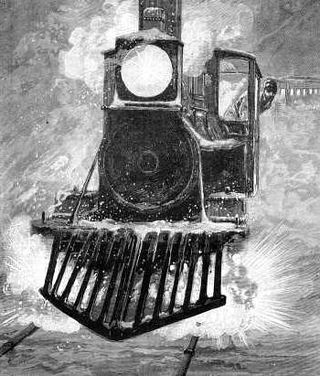
A railway detonator, or fog signal is a coin-sized device that is used as a loud warning signal to train drivers. It is placed on the top of the rail, usually secured with two lead straps, one on each side. When the wheel of the train passes over, it explodes, emitting a loud bang. It was invented in 1841 by English inventor Edward Alfred Cowper.

Parking sensors are proximity sensors for road vehicles designed to alert the driver of obstacles while parking. These systems use either electromagnetic or ultrasonic sensors.
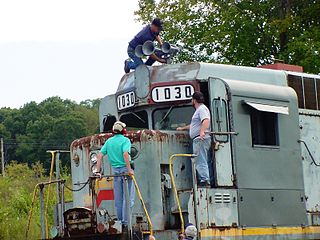
A train horn is an air horn used as an audible warning device on diesel and electric-powered trains. Its primary purpose is to alert persons and animals to an oncoming train, especially when approaching a level crossing. They are often extremely loud, allowing them to be heard from great distances. They are also used for acknowledging signals given by railroad employees, such as during switching operations. For steam locomotives, the equivalent device is a train whistle.

Automatic block signaling (ABS), spelled automatic block signalling or called track circuit block (TCB) in the UK, is a railroad communications system that consists of a series of signals that divide a railway line into a series of sections, called blocks. The system controls the movement of trains between the blocks using automatic signals. ABS operation is designed to allow trains operating in the same direction to follow each other in a safe manner without risk of rear-end collision.
The current French railway signalling system is in force on the Réseau Ferré de France since 1930, when the code Verlant was applied.
The anti-collision device (ACD) is a form of automatic train protection used on Indian Railways.
Belgian railway signalling is the signalling in effect on the Belgian rail network currently operated by Infrabel.

A vehicle horn is a sound-making device installed on motor vehicles, trains, boats, and other types of vehicles. The horn is activated to warn others of the vehicle's presence or approach, or to call attention to some hazard. Motor vehicles, ships and trains are required by law in some countries to have horns. Trams, trollies, streetcars, and even bicycles are also legally required to have an audible warning device in many areas.
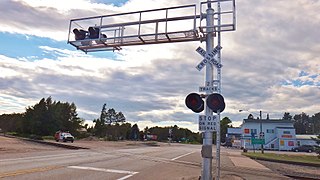
Level crossing signals are the electronic warning devices for road vehicles at railroad level crossings.

There are around 6,000 level crossings in the United Kingdom, of which about 1,500 are public highway crossings. This number is gradually being reduced as the risk of accidents at level crossings is considered high. The director of the UK Railway Inspectorate commented in 2004 that "the use of level crossings contributes the greatest potential for catastrophic risk on the railways." The creation of new level crossings on the national network is banned, with bridges and tunnels being the more favoured options. The cost of making significant reductions, other than by simply closing the crossings, is substantial; some commentators argue that the money could be better spent. Some 5,000 crossings are user-worked crossings or footpaths with very low usage. The removal of crossings can improve train performance and lower accident rates, as some crossings have low rail speed limits enforced on them to protect road users. In fact, between 1845 and 1933, there was a 4 miles per hour (6.4 km/h) speed limit on level crossings of turnpike roads adjacent to stations for lines whose authorising act of Parliament had been consolidated in the Railways Clauses Consolidation Act 1845 although this limit was at least sometimes disregarded.
Designs of level crossings, where railway lines cross roads or other paths, vary country-to-country.















